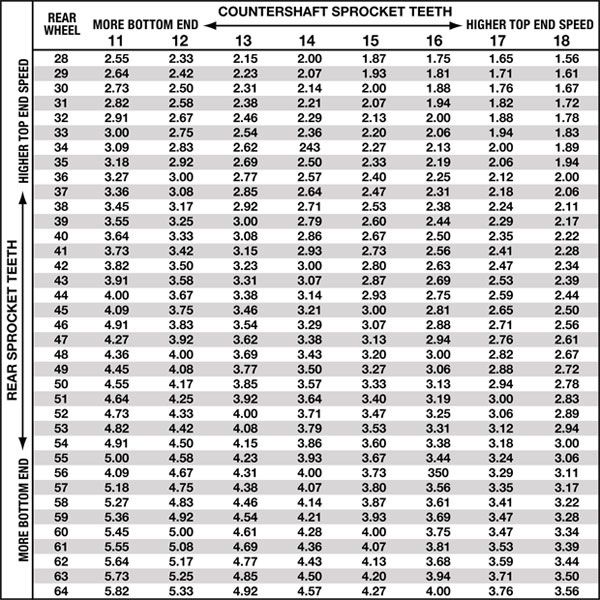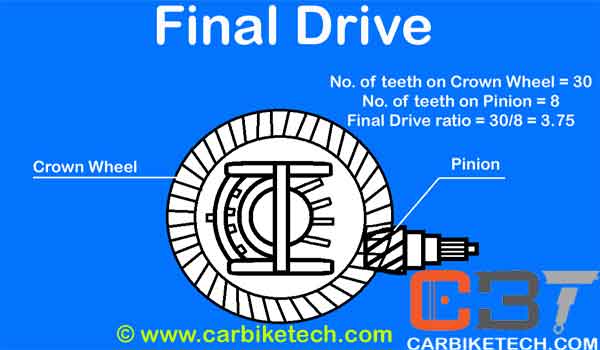Final Drive Ratio Meaning
See how gears work for more information on gear ratios. Rear end gear ratios or final drive ratio refers to the number of revolutions the drive shaft turns compared to one full revolution of rear wheels.


Choosing your right gearing is all about ‘compromise’.


Final drive ratio meaning. Differential gear ratio (also known as final gear) changing a diff to better suit larger wheels/tires is a good idea and in some cases is a must. This definition appears somewhat frequently and is found in the following acronym finder categories: The gear ratio is the ratio of the number of turns the output shaft makes when the input shaft turns once.
We'll assume here that the guy is 100% honest and not lying through his teeth like a lot of racers do to their opposition when asked to divulge some of their speed secrets. For example, a truck with a 3.73:1 gear ratio means that the driveshaft will turn 3.73 times for each complete wheel spin. Gear ratio is simply the gear ratio of the mating gears in the transmission system.
The final drive ratio of this type of vehicle is 1:1 (one revolution of “transmission” equals one revolution of the wheels) so as an effect of this, these types of cars are very fast. What is the final drive ratio? Gear ratio is simply a number that defines the torque multiplication value that multiple gears can create.
As you have seen, you have worked out your final drive ratio at 12.5:1. Changing the final drive ratio heavily impacts the way the car behaves. For every one turn of the output shaft leading to a tire, the final drive ratio represents how many times the pinion gear on the motor shaft must turn.
A lower (taller) gear ratio provides a higher top speed, and a higher (shorter) gear ratio provides faster acceleration. The differential ratio is fixed so the only variable is the transmission gear ratio. For example, a final drive ratio of 8.17:1 means that for.
Final drive ratio is generally referring to the drive axle gear ratio. This means that the natural frequencies of the two gears will act in sympathy and consequently cause noise and, in severe cases, gear damage. In other words, the gear ratio is the ratio between the number of teeth on two gears that are meshed together, or two sprockets connected with a common roller chain, or the circumferences of two pulleys connected with a drive belt.
This is why final drive ratios of exactly 3:1, 4:1 or any other combinations of whole numbers are never used in this manner. Final drive ratio the relationship between the speed of the motor and the speed of the driving wheels. Fofor example in a final drive the pinion gear(input) has 10 teeth and is driving the ring gear(output) that.
If you alter this ratio, it also alters every gear's effective ratio, thereby affecting the. See other definitions of fdr. Final drive ratio he is running.
The final drive ratio is typically the gear ratio for the differential, or the final location where the gearing is altered before being sent to the wheels. The number is expressed in a ratio, which represents the number of teeth on the ring gear divided by the number of teeth on the pinion. To keep the problem to a minimum, transmission designers prefer to use.
You may have heard terms like rear axle ratio or final drive ratio. Besides the gears in the transmission, there is also a gear in the rear differential. The final drive is sometimes also referred to as 'the product of all ratios involved' but i prefer to call that the 'total' or 'overall' ratio.
If you increase the final drive ratio, each gear will have greater wheel torque, while sacrificing top speed. Overall, the final drive ratio of your truck has a minor impact on fuel economy compared to other factors, such as low tire pressure, overuse of air conditioning, an inefficient or neglected engine, and frequent rapid acceleration. This is known as the final drive.
Fdr stands for final drive ratio (automotive) suggest new definition. By changing it, you can affect the performance of. The final drive ratio is the last bit of gearing between your transmission and the driven wheels.
When a car makes a turn, the wheels must spin at different speeds. Final drive ratio is the product of your transmission gear ratio and the gear ratio of the differential that drives the wheel. You need to change your ratio from 12.5 to 13.
In our example the final drive ratio is the ratio of the final part of the gearing, the ratio between rear and front sprocket. And by fitting a shorter final drive you can achieve better acceleration, since you can increase the amount of torque to the wheels, or you can fit a taller one. You could then use this value to determine the total amount of output torque produced as long as you know the total input torque.
These refer to the gear ratio in the differential. If the final drive ratio is 4.10, then the ring gear has 4.10 times as many teeth as the input pinion gear. A 2.90 gear ratio means the drive shaft turns 2.9 times in one full turn of the rear wheels.
This is known as the final drive, differential gear, crown wheel pinion (cwp) or ring and pinion.























0 Response to "Final Drive Ratio Meaning"
Post a Comment